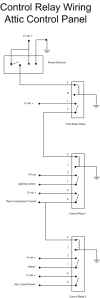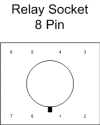
Automatic Power Controls
Some appliances should be disconnected when not in use to prevent unnecessary power drain. Some of these are 110 volt, other 12 volt. So a control mechanism was required. A motion detector was the obvious choice. Motion detectors designed to control lighting are available, but only work with 110 volts, and incandescent, or resistive, loads. One attractive feature of these units is the built-in adjustable time delay feature that keeps the load energized for a period after activation. Part of our load was low voltage.
There are a variety of motion detectors designed for security systems that operate at 12 volts, but their switching is only intended to operate a control circuit, not a heavier load, and these units do not include any delay features. Ultimately one of these units was chosen.
The unit was the Optex LX-402, sourced from SmartHome.com. This unit was chosen primarily because it offered the option of a normally-open output that closed on activation. This was desirable because it should not draw power until activated. Most alarm system applications use a normally-closed condition that opens on activation. The unit is also designed for outdoor use, so it should be immune to moisture and hair.
To get the required time delay, a separate time delay relay is used. There are a lot of these available in the industrial controls space. It took some searching to find the NTE Electronics Model R61-11AD10-12, which is a 12 volt operated unit with delay range adjustable in minutes. It is a sealed unit with a standard 11 pin base for socket mounting.
Additional general purpose relays are used to switch the load to the controlled devices. All the relays are manufactured by NTE Electronics.
 |
Relays in front, attic. Includes time delay relay |
 |
Water pump power control |
 |
Inverter genset auto-start controls |
 |
8 pin socket |
 |
11 pin socket |